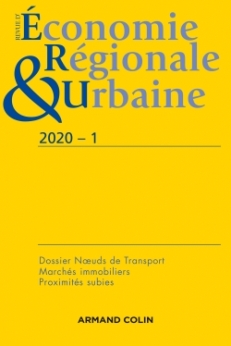
Revue d'économie régionale et urbaine (1/2020)
Pour acheter ce numéro, contactez-nous
Recevez les numéros de l'année en cours et accédez à l'intégralité des articles en ligne.
Après une lente déconnexion des villes et des fleuves qui les irriguent, certaines d’entre-elles en redécouvrent les vertus, notamment pour le transport de marchandises. Dans ce contexte, l’objectif de l’article est d’appréhender dans quelle mesure la perspective du développement du transport fluvial de marchandises, tant invoqué par les politiques nationales et européennes de développement durable, se territorialise dans les processus d’aménagement locaux, au travers de deux projets portuaires du Valenciennois. À l’aune du concept de « système territorial d’aménagement », nous formulons l’hypothèse que les représentations des ports fluviaux influencent les cadres du dialogue ville-port et les formes de leur aménagement. Ainsi sur l’Escaut, la pérennisation de la représentation du transport fluvial comme générateur de développement économique conduit à structurer un système d’acteurs où les autorités publiques en charge de l’aménagement privilégient le dialogue avec les représentants des firmes, mais renforce aussi la déconnexion spatiale entre la ville et le port.
After several decades of disconnection between rivers and cities, some cities are rediscovering the values of rivers, particularly for goods transportation. In this context, the paper aims to apprehend how projects of waterway goods transportation development, mentioned in European and national sustainable development policies, are territorialized. The local planning processes of two river port projects on the Escaut river in the Valenciennes area are analyzed. Although both river port projects emerged in the early 2000’s, only one was carried out. Why ? Considering the concept of territorial planning system suggested by Moine (2006), we hypothesise that social representations of river ports and waterway transportation frame the city-port dialogue and the spatial planning shapes of their interface. Along the Escaut river edges, public authorities in charge of spatial planning consider the representation of waterway transportation as an economic development generator. As they have no competence regards to logistics and freight, local planning stakeholders rely on the local Industry and Trade Council to facilitate the dialogue with firms. Consequently, they have created a specific organization to build up the ports, in association with the local Industry and Trade Council. This organisation is able to design ports that fit well to the local economic activities : why and where to build a bulk handling port or a container terminal. However, this planning framework also strengthens the spatial disconnection between the city and its ports. Furthermore, the political conflicts taking place within the Valenciennes planning stakeholders influence the speed of the port projects implementation.

